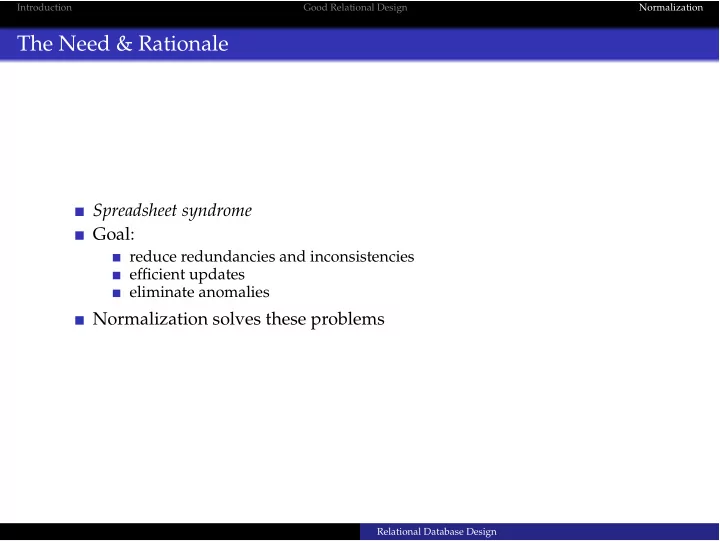

Introduction Good Relational Design Normalization The Need & Rationale Spreadsheet syndrome Goal: reduce redundancies and inconsistencies e ffi cient updates eliminate anomalies Normalization solves these problems Relational Database Design
Introduction Good Relational Design Normalization Normal Forms Criteria for safety against anomalies & inconsistencies Usually 3 to 7 normal forms ( 1NF → 7NF ) First 3: how non-key attributes relate to key 4th & 5th: many-to-one, many-to-many Must be satisfied progressively May combine several in one step Highest Normal Form ( HNF ) Applied to individual tables Relational Database Design
Introduction Good Relational Design Normalization First Normal Form A relation is a relation: no repetition in a tuple one (at least) unique key no nullable attribute (optional) Atomic attribute values For e.g., decompose multi-valued attributes Atomicity can be extreme: date , strings Relational Database Design
Introduction Good Relational Design Normalization Second Normal Form Conditions: Relation is in 1NF No non-prime attributes functionally depend on subset of PK Relational Database Design
Introduction Good Relational Design Normalization Second Normal Form Conditions: Relation is in 1NF No non-prime attributes functionally depend on subset of PK Not in 2NF: books ( book name , author name , review ) skills ( employee name , skill , address ) Relational Database Design
Introduction Good Relational Design Normalization Second Normal Form Conditions: Relation is in 1NF No non-prime attributes functionally depend on subset of PK Not in 2NF: books ( book name , author name , review ) skills ( employee name , skill , address ) Solution: separate into multiple relations Relational Database Design
Introduction Good Relational Design Normalization Second Normal Form Conditions: Relation is in 1NF No non-prime attributes functionally depend on subset of PK Not in 2NF: books ( book name , author name , review ) skills ( employee name , skill , address ) Solution: separate into multiple relations For e.g.: employee name , skill and employee name , address Both are in 2NF Relational Database Design
Introduction Good Relational Design Normalization Second Normal Form Conditions: Relation is in 1NF No non-prime attributes functionally depend on subset of PK Not in 2NF: books ( book name , author name , review ) skills ( employee name , skill , address ) Solution: separate into multiple relations For e.g.: employee name , skill and employee name , address Both are in 2NF single primary key ⇒ 2NF Relational Database Design
Introduction Good Relational Design Normalization Second Normal Form Conditions: Relation is in 1NF No non-prime attributes functionally depend on subset of PK Not in 2NF: books ( book name , author name , review ) skills ( employee name , skill , address ) Solution: separate into multiple relations For e.g.: employee name , skill and employee name , address Both are in 2NF single primary key ⇒ 2NF Can have anomalies in 2NF AuthorAwards ( award name , award year , author name , date of birth ) Relational Database Design
Introduction Good Relational Design Normalization Third Normal Form Conditions: Relation is in 2NF Every non-key is directly dependent on the key “every non-key attribute must provide a fact about the key, the whole key, and nothing but the key.” Relational Database Design
Introduction Good Relational Design Normalization Third Normal Form Conditions: Relation is in 2NF Every non-key is directly dependent on the key “every non-key attribute must provide a fact about the key, the whole key, and nothing but the key.” AuthorAwards ( award name , award year , author name , date of birth ) Relational Database Design
Introduction Good Relational Design Normalization Third Normal Form Conditions: Relation is in 2NF Every non-key is directly dependent on the key “every non-key attribute must provide a fact about the key, the whole key, and nothing but the key.” AuthorAwards ( award name , award year , author name , date of birth ) date of birth intransitively dependent on key ( author name , award year ) → author name → date of birth Solution: separate into multiple relations AuthorAwards ( award name , award year , author name ) & Author ( author name , date of birth ) Other examples: Employees ( Empl id , Empl name , Dept name , Dept floor ) : Relational Database Design
Introduction Good Relational Design Normalization Third Normal Form Conditions: Relation is in 2NF Every non-key is directly dependent on the key “every non-key attribute must provide a fact about the key, the whole key, and nothing but the key.” AuthorAwards ( award name , award year , author name , date of birth ) date of birth intransitively dependent on key ( author name , award year ) → author name → date of birth Solution: separate into multiple relations AuthorAwards ( award name , award year , author name ) & Author ( author name , date of birth ) Other examples: Employees ( Empl id , Empl name , Dept name , Dept floor ) : Employees ( Empl id , Empl name , Dept id ) and Department ( Dept id , Dept name , Dept floor ) 3NF: free of update, insertion, and deletion anomalies Relational Database Design
Introduction Good Relational Design Normalization Fourth Normal Form Only many-to-one and many-to-many Relational Database Design
Recommend
More recommend